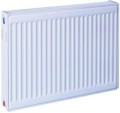Burst pressure
The burst pressure of the radiator is the water pressure, upon reaching which the product will inevitably be damaged.
The main practical specs of the radiator are the working and maximum pressure (see above); it is on them that one should focus when choosing. The burst pressure is given in the description mainly for promotional purposes: other things being equal, a higher value means greater reliability and resistance to emergencies.
Pipe centre distance
The distance between the axes of the inlet and outlet manifolds of the radiator or its separate section.
The dimensions of the product and the possibility of installing the heater in specific conditions, taking into account the peculiarities of the pipe connection, directly depend on this parameter. The parameter is indicated mainly for models of traditional design - with two horizontal pipes at the top and bottom, between which vertical channels of the heat transfer are laid.
The centre distance determines at least the overall height of the product, and in radiators with sideward connection (see the corresponding paragraph), it also determines the features of the organization of this connection.
As for specific values, the most common models in our time are
250 mm,
350 mm,
450 mm,
550 mm and
850 mm. Solutions for
150 mm,
400 mm,
500 mm and
700 mm are noticeably less common.
Connection size
The diameter of the thread used to connect the radiator to the heating system. Modern radiators use standard sizes — for example,
3/4" or
1/2", less often
1" and
1 1/4". This indicator must match the dimensions of the pipes, couplings and other elements directly used for connection — otherwise, at best, you will need to install adapters, and at worst, the radiator will turn out to be unusable at all.
Usually, the larger the thread diameter, the more powerful the radiator (high power requires intensive circulation of the heating medium and an appropriate throughput at the inlet and outlet).
Heat output
The rated thermal output of the radiator is the amount of heat given off to the air in normal operation.
When choosing this parameter note that the heat output will depend on the temperature difference at the inlet and outlet to the radiator, as well as on the ambient temperature. The greater the temperature difference and the colder it is around, the more intense the heating will be. Therefore, in the specs, it is customary to indicate heat transfer for certain standard conditions. In particular, the designation according to the European standard EN-442 is very popular, which assumes heating medium temperatures of +75 °С and +65 °С at the inlet and outlet, respectively, as well as an air temperature of +20 °С. Real conditions and the actual heat output of the radiator may differ; therefore, when choosing, it is best to choose a model with a certain margin and compensate for excess power with one or another regulator. As for the actual values, in the most modest models, the heat output
does not exceed 750 W, or even
500 W, and in the largest, this figure can reach
3.5 – 4 kW or
more.
The choice for this parameter depends primarily on the size and specs of the heated space. The simplest calculation formula is as follows: at least 100 W of thermal power is required per 1 m2 of area. This formula is relevant for standard r
...esidential/office premises with ceilings of 2.5 – 3 m, without problems with thermal insulation; for more specific conditions, there are more detailed calculation methods, that can be found in special sources.
